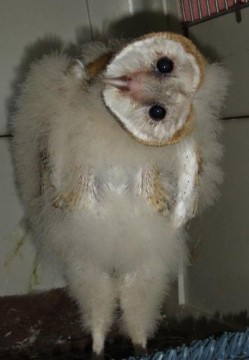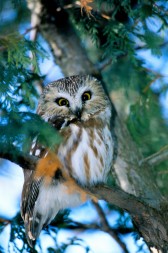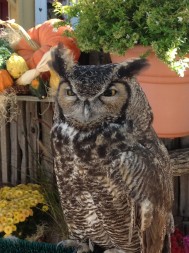
As Halloween nears, my thoughts turn to our local, enchanted forest at Redwood Regional Park. After dark, it’s a whole different habitat with nocturnal animals prowling and flying while the daytime inhabitants sequester themselves for survival and sleep. A significant number of owl species can be found in the redwood forest, bay-oak woodland and chaparral habitats along either side of the canyon. In fact, a birder reported hearing or sighting six species of owls in the park on just one “Big Day” of birding back in September. His list included barn, Western screech, great horned, Northern pygmy, long-earred and Northern saw-whet owls.
So, tonight we trekked into the dark, moist woodlands and I spent a few hours preparing to lead an “Owl Moon” walk for families in a couple of weeks. The cricket chorus was a backdrop of sound, echoing through the canyon. Our shoes squished quietly in the duff that had soaked up the first rain of the season. The breeze swayed the branches overhead and carried the sharp-fresh scent of bay leaves. I strained to hear any quiet metronome-like whooping of a saw-whet or accelerating "bouncing ball" call of the Western screech owl. We surprised a couple of deer who rushed across the trail and down into the creek. At several stops I tried my great horned owl call, hoping to get a response. The only reply was the quiet of a night alone in the park.

Further along the trail, we paused to listen. We noticed the last of the garden spiders with any impressive web stretched between two redwoods. Hooting into the darkness, we still got no reply. As we headed back toward the parking lot, talking quietly, we made one more stop under the trees by the creek. A large, dark shape soared close, just overhead. It silently flapped several times, and then glided into the darkness through the trees. No flash of white, and its size made it likely a great horned owl. Then, in the next meadow over, I heard the unmistakable screech of a barn owl. We called tonight a “two-owl” success!

You can get out into your own local woodlands or park and try your luck at “owling.” The fall and winter are actually good times to look and listen for owls. Some owls set up territories now or seek mates or even maintain their pair bonds, as most are monogamous and return year after year to the same nesting sites. Barn owls can be found in the city throughout the year and nest in palm trees and nest boxes. There are plenty of rodents for them to eat in our local parks and neighborhoods and they serve as important pest control species. Do them a favor by not using rat poisons as they can be killed by secondary poisoning. Join a night hike with one of the East Bay Regional Parks naturalists to learn more about the nocturnal inhabitants of the parks. You may even be inspired to improve your neighborhood for owls by constructing and installing an owl nest box. The photos used in this post by Carolyn Lie were provided through Native Bird Connections (NBC). NBC cares for injured raptors and bring ambassador, non-releasable animals to schools and other public facilities to help others learn more about these important wildlife species. You can join NBC and me on Sun., October 28 from 3-4pm in the Alameda Free Library for a free program.